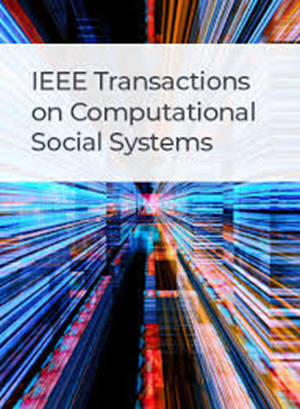基于分层超图消息传递网络的大规模流量预测
IF 4.5
2区 计算机科学
Q1 COMPUTER SCIENCE, CYBERNETICS
IEEE Transactions on Computational Social Systems
Pub Date : 2024-09-10
DOI:10.1109/TCSS.2024.3419008
引用次数: 0
摘要
图卷积网络(GCNs)广泛应用于城市交通预测等社会计算领域。然而,当面对城市级别的预测挑战时,基于图的深度学习方法难以有效地处理大规模多元数据。为了解决可扩展性有限的问题,本文提出了一个基于超图消息传递网络(hypergraph message passing network, HMSG)的流量预测框架。该模型用超图表示城市交通网络,其中节点表示交通枢纽,超边表示它们在地理和特征层面的关系。与配对边相比,超边具有更强的可扩展性和灵活性,能够更好地描述交通信息。HMSG算法分两步更新节点和超边缘特征,实现了隐藏空间特征的跨层高效集成。在大规模历史数据集上对所提出的框架进行了评估,并证明其完成了城市规模的交通预测任务。结果表明,该方法在小尺度数据集上的预测精度与现有的交通预测方法相当。这验证了基于HMSG算法的交通预测模型在智能交通应用中的潜力。本文章由计算机程序翻译,如有差异,请以英文原文为准。
Large-Scale Traffic Prediction With Hierarchical Hypergraph Message Passing Networks
Graph convolutional networks (GCNs) are widely used in social computation such as urban traffic prediction. However, when faced with city-level forecasting challenges, the graph-based deep learning methods struggle to process large-scale multivariate data effectively. To address the challenges of limited scalability, a traffic prediction framework based on a hypergraph message passing network (HMSG) is proposed in this article. The model represents the urban transportation network with hypergraph, where nodes denote transportation hubs and hyperedges represent their relationship at geographical and feature level. Compared with pairwise edges, hyperedges are more scalable and flexible, providing a more descriptive representation of traffic information. The HMSG algorithm updates node and hyperedge features in two steps, facilitating effective and efficient integration of hidden spatial features across layers. The proposed framework is evaluated on large-scale historical datasets and demonstrates its completion of city-scale traffic prediction tasks. The results also show that it matches the accuracy of existing traffic prediction methods on small-scale datasets. This validates the potential of the traffic prediction model based on the HMSG algorithm for intelligent transportation applications.
求助全文
通过发布文献求助,成功后即可免费获取论文全文。
去求助
来源期刊

IEEE Transactions on Computational Social Systems
Social Sciences-Social Sciences (miscellaneous)
CiteScore
10.00
自引率
20.00%
发文量
316
期刊介绍:
IEEE Transactions on Computational Social Systems focuses on such topics as modeling, simulation, analysis and understanding of social systems from the quantitative and/or computational perspective. "Systems" include man-man, man-machine and machine-machine organizations and adversarial situations as well as social media structures and their dynamics. More specifically, the proposed transactions publishes articles on modeling the dynamics of social systems, methodologies for incorporating and representing socio-cultural and behavioral aspects in computational modeling, analysis of social system behavior and structure, and paradigms for social systems modeling and simulation. The journal also features articles on social network dynamics, social intelligence and cognition, social systems design and architectures, socio-cultural modeling and representation, and computational behavior modeling, and their applications.
 求助内容:
求助内容: 应助结果提醒方式:
应助结果提醒方式:


